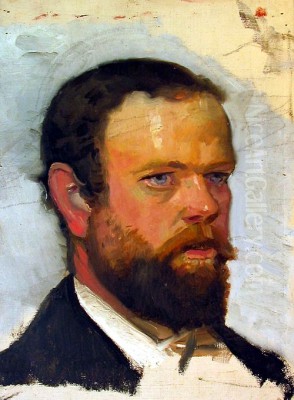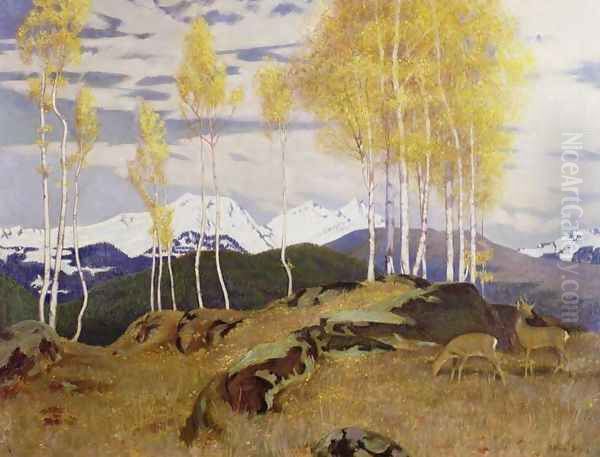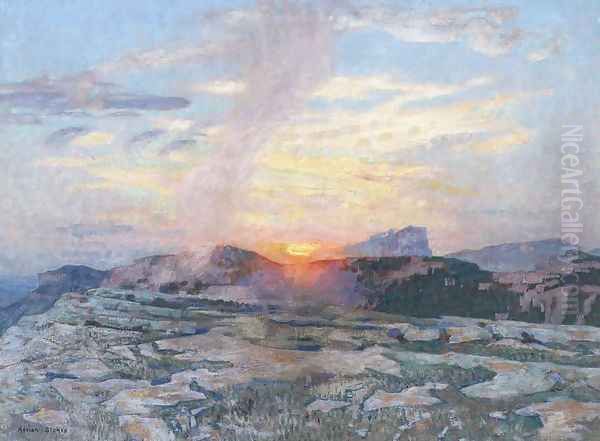
Adrian Scott Stokes (1854–1935) stands as a distinguished figure in the annals of British art, celebrated primarily for his evocative landscape paintings. His career spanned a period of significant artistic evolution, from the High Victorian era into the early 20th century, witnessing the rise of Impressionism, Post-Impressionism, and various plein-air movements. Stokes, a quintessential British artist, carved his niche by capturing the subtle atmospheric effects and the tranquil beauty of the natural world, particularly the landscapes of England, Denmark, and later, Austria and Hungary, alongside his artist wife, Marianne Stokes.
Early Life and Artistic Awakening
Born in Southport, Lancashire, in 1854, Charles Adrian Scott Stokes initially embarked on a commercial career. He worked as a cotton broker in Liverpool, a path that seemed far removed from the artistic pursuits that would later define his life. However, the allure of art proved irresistible. A pivotal moment came with the encouragement of John Herbert RA, a respected Royal Academician, who recognized Stokes's latent talent and advised him to pursue art professionally.
Heeding this counsel, Stokes made a decisive shift. In 1872, he enrolled at the prestigious Royal Academy Schools in London. This institution was the bastion of academic art training in Britain, emphasizing rigorous drawing skills and a classical approach. Stokes immersed himself in his studies, laying the technical groundwork that would underpin his later, more expressive, landscape work. By 1876, he began exhibiting his paintings at the Royal Academy, marking his official entry into the British art world.
Formative Influences and European Sojourns
During his formative years, Stokes, like many of his contemporaries, was drawn to the artistic developments unfolding on the Continent, particularly in France. The Barbizon School, with artists like Jean-François Millet and Camille Corot, had already championed landscape painting and rural scenes. This was followed by the revolutionary impact of Impressionism, pioneered by artists such as Claude Monet, Camille Pissarro, and Alfred Sisley, who emphasized capturing fleeting moments of light and atmosphere through plein-air (outdoor) painting.

Stokes spent time in France, notably at Fontainebleau, a hub for landscape painters, and later in Brittany at Pont-Aven, which attracted artists like Paul Gauguin and Émile Bernard. These experiences exposed him to the principles of plein-air painting and the nuanced depiction of natural light, which became central to his artistic philosophy. He absorbed the French dedication to observing nature directly, moving away from the more studio-bound, narrative traditions prevalent in much Victorian art.
A Pivotal Partnership: Marriage to Marianne Preindlesberger
A significant chapter in Adrian Stokes's life and artistic journey began in 1884 when he married the Austrian painter Marianne Preindlesberger (later Marianne Stokes). Marianne was a formidable artist in her own right, trained in Munich and Paris, and associated with the naturalist movement. Their union was not just personal but also a deep artistic partnership. They shared a passion for travel and painting, and their careers often intertwined.
Together, they embarked on numerous painting expeditions across Europe. Marianne initially focused on rustic genre scenes, often with a poignant, social-realist undertone, influenced by artists like Jules Bastien-Lepage. Adrian, meanwhile, continued to develop his landscape art. Their mutual support and shared artistic environment undoubtedly enriched both their practices.
The Scandinavian Sojourn: Skagen and its Luminous Artistry
In 1885 and 1886, Adrian and Marianne Stokes spent considerable time in Skagen, a remote fishing village at the northern tip of Denmark. Skagen had become a magnet for a group of Scandinavian artists known as the Skagen Painters, including Michael Ancher, Anna Ancher, and P.S. Krøyer. These artists were renowned for their depictions of the local fisherfolk and the unique, luminous quality of light in the region, where the Skagerrak and Kattegat seas meet.
The Stokeses integrated into this vibrant artistic community. Adrian was particularly captivated by the atmospheric conditions and the expansive coastal scenery. His paintings from this period reflect the influence of the Skagen Painters' commitment to naturalism and their ability to capture the interplay of light on water and land. This experience further honed his skills in rendering subtle tonal variations and atmospheric depth, characteristics that would become hallmarks of his work.
Cornwall's Embrace: The St Ives and Newlyn Art Colonies
Following their experiences in France and Denmark, Adrian and Marianne Stokes eventually settled in England, drawn to the burgeoning art colony in Cornwall. They initially spent time in Lelant and later became prominent figures in St Ives. Cornwall, with its dramatic coastline, picturesque fishing villages, and special quality of light, had attracted a wave of artists seeking to work directly from nature, away from the industrial centers.

The Newlyn School, centered in the nearby fishing village of Newlyn, had already established a reputation for social realist and plein-air painting, with leading figures like Stanhope Forbes, Elizabeth Forbes (née Armstrong), Walter Langley, and Frank Bramley. The St Ives art colony, while sharing some of these ideals, also developed its own distinct character. Adrian Stokes became an integral part of this community, alongside artists such as Julius Olsson, who was famed for his nocturnes and marine paintings, and Lamorna Birch, known for his depictions of the Cornish landscape.
Stokes's Cornish landscapes often feature the rugged cliffs, sandy coves, and pastoral inland scenes of the region. He was adept at capturing the specific mood and atmosphere of the Cornish weather, from bright, sunlit days to misty, ethereal mornings. His work from this period shows a mature command of his medium, blending observational accuracy with a poetic sensibility.
The Essence of Stokes's Art: Style, Subject, and Atmosphere
Adrian Scott Stokes was pre-eminently a landscape painter. His style evolved from a more detailed, Victorian approach to a broader, more atmospheric manner, influenced by Impressionism but never fully adopting its broken brushwork or high-keyed palette. Instead, he favored a more tonal approach, emphasizing harmonious color schemes and the subtle gradations of light and shadow.
His subjects were typically rural and coastal scenes, often devoid of overt narrative or human drama, allowing the landscape itself to be the primary focus. He was particularly interested in capturing the effects of different times of day and weather conditions – the golden light of sunset, the cool blues of twilight, or the soft diffusion of light on an overcast day. Works like Autumn in the Mountains or The Setting Sun exemplify his ability to convey a profound sense of place and mood.
While he painted figures within landscapes, such as in The Shepherd, the human element often served to complement the natural setting rather than dominate it. His compositions are generally calm and well-balanced, inviting contemplation. There is a quiet dignity to his work, a deep respect for the natural world that resonates with viewers. He was also a capable author, publishing books on their travels, such as Hungary (1909) and Austria (1909), both painted by Adrian and described by Marianne, showcasing their collaborative spirit.
Notable Canvases: Capturing the Spirit of Place
Several paintings stand out as representative of Adrian Scott Stokes's artistic achievements. Sunset, for instance, showcases his mastery in depicting the transient beauty of light at the end of the day. The warm hues of the sky, reflected in water or casting long shadows across the land, are rendered with great sensitivity.
Sheep grazing by the Lizard, Cornwall is another characteristic work, capturing a quintessential Cornish scene. The painting likely depicts the rugged beauty of the Lizard Peninsula, with its distinctive serpentine rock and coastal heathland. The sheep, a common motif in pastoral landscapes, are integrated naturally into the scene, adding a touch of rustic charm. Stokes's ability to render the texture of the grass, the quality of the light, and the expansive feel of the coastal landscape would have been evident in such a piece.
His painting The Shepherd (or similar pastoral themes) would highlight his interest in traditional rural life, echoing the concerns of artists like George Clausen or Henry Herbert La Thangue, who also depicted agricultural labor and the English countryside with a blend of realism and romanticism. However, Stokes's primary focus remained the landscape itself, its inherent beauty and atmospheric qualities.
Other works, often titled simply with their location or the time of day, such as A Winter's Afternoon, St Ives Bay or A Grey Day on the Cornish Coast, further attest to his dedication to capturing specific moments in nature. His oeuvre demonstrates a consistent engagement with the challenges of landscape painting, particularly the rendering of light and air.
Later Years and Enduring Legacy
Adrian Scott Stokes continued to exhibit regularly at the Royal Academy and other prestigious venues throughout his career. He was elected an Associate of the Royal Academy (ARA) in 1909 and a full Royal Academician (RA) in 1919, prestigious honors that recognized his significant contributions to British art. He also served as president of the Royal Society of Painters in Water Colours.
He and Marianne spent their later years in London, though they continued to travel and paint. Adrian Stokes passed away in London in 1935, leaving behind a substantial body of work that testifies to his lifelong dedication to landscape painting. His wife, Marianne, had passed away earlier in 1927.
His legacy is that of a highly accomplished and respected landscape painter who successfully navigated the changing artistic currents of his time. While perhaps not as revolutionary as some of his avant-garde contemporaries, Stokes excelled in his chosen genre, producing works of enduring beauty and quiet power. His paintings are held in numerous public collections, including the Tate Britain, and continue to be appreciated for their technical skill and sensitive portrayal of the natural world.
Artists like Arnesby Brown, another contemporary known for his pastoral landscapes, shared a similar affinity for the British countryside, though Stokes's work often had a broader, more international scope due to his travels. He can be seen as part of a lineage of British landscape painters that includes John Constable and J.M.W. Turner, who similarly sought to capture the essence of their native land, albeit with different stylistic approaches.
Stokes in the Tapestry of Art History
Adrian Scott Stokes occupies an important place within the context of late 19th and early 20th-century British art. He represents a generation of artists who, while rooted in academic training, were open to the influences of continental movements like Impressionism and plein-air painting. He skillfully blended these influences with a distinctly British sensibility, creating a body of work that is both traditional and forward-looking.
His association with the art colonies of Skagen and St Ives places him at the heart of significant artistic communities that fostered innovation and a shared commitment to capturing the natural world. These colonies provided supportive environments where artists could exchange ideas and develop their individual styles. The work produced in these locales, including Stokes's contributions, played a crucial role in the development of landscape and genre painting in Britain and beyond.
Compared to the more radical experiments of Post-Impressionists like Roger Fry or the Bloomsbury Group artists such as Duncan Grant or Vanessa Bell, Stokes's art remained more aligned with a representational tradition. Yet, within that tradition, he demonstrated a sophisticated understanding of light, color, and composition, creating landscapes that are both visually appealing and emotionally resonant. His dedication to capturing atmospheric effects aligns him with the broader concerns of Impressionist-influenced painters across Europe, such as the American Impressionist Childe Hassam or the Australian Arthur Streeton, who also sought to depict the unique light of their respective environments.
Conclusion: A Lasting Impression
Adrian Scott Stokes was a painter of quiet conviction and considerable skill. His life was dedicated to the pursuit of capturing the ephemeral beauty of the landscape, from the rugged coasts of Cornwall and Denmark to the pastoral heartlands of England and the mountainous terrains of Austria. His partnership with Marianne Stokes further enriched his artistic journey, creating a unique husband-and-wife artistic duo prominent in their era.
His legacy is preserved in his luminous canvases, which continue to offer a window onto the natural world as he perceived it – a world of subtle beauty, shifting light, and profound tranquility. As an artist who successfully bridged Victorian traditions with modern sensibilities, and as a key figure in important art colonies, Adrian Scott Stokes remains a significant and respected name in the history of British landscape painting, admired for his technical mastery and his poetic vision of nature. His work stands as a testament to the enduring appeal of landscape art and the artist's ability to convey the profound connection between humanity and the natural environment.